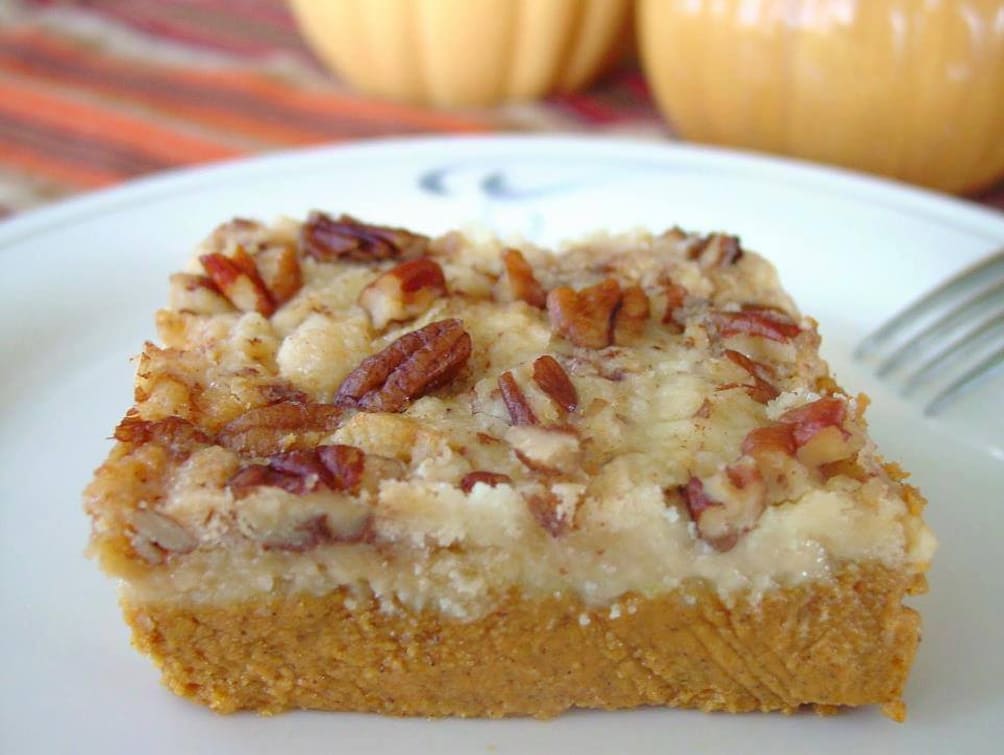spice cake mix instead of yellow cake mix for added warmth and flavor.
Conclusion:
Pumpkin Pie Cake brings the essence of autumn to your dessert table. Its harmonious blend of pumpkin spice flavors and cake-like topping creates a memorable treat for fall gatherings and Thanksgiving dinners. With a straightforward recipe like this, you can easily whip up a Pumpkin Pie Cake that will have everyone asking for seconds.
Here’s a rough breakdown of the nutrition information for one serving of Pumpkin Pie Cake (assuming the cake is cut into 12 equal servings, without whipped cream or ice cream):
Calories: Approximately 350-400 calories per serving.
Protein: About 3-5 grams of protein per serving, primarily from the eggs in the pumpkin filling.
Carbohydrates: Approximately 40-45 grams of carbohydrates per serving, mainly from the cake mix and granulated sugar.
Dietary Fiber: Minimal dietary fiber, typically less than 1 gram per serving.
Sugars: Around 25-30 grams of sugar per serving, primarily from the granulated sugar in the pumpkin filling and cake mix.
Fats: Approximately 20-25 grams of total fat per serving, mainly from the butter used in the cake topping.
Saturated Fat: Roughly 10-12 grams of saturated fat per serving, primarily from the butter.
Cholesterol: About 75-85 milligrams of cholesterol per serving, primarily from the eggs in the pumpkin filling and the butter.
Sodium: Approximately 400-500 milligrams of sodium per serving, with variations based on the brand of ingredients used.
Vitamins and Minerals: Pumpkin Pie Cake provides some vitamin A and calcium from the pumpkin puree and evaporated milk, but it is not a significant source of vitamins and minerals.
Note: These nutritional values are approximate and can vary based on factors like the specific brands of ingredients used and the size of the serving. Pumpkin Pie Cake is a delicious seasonal dessert, but it’s important to enjoy it in moderation as part of a balanced diet, especially if you’re watching your calorie, sugar, or fat intake.
The history of Pumpkin Pie Cake can be understood within the broader context of the history of pumpkin-based desserts and the evolution of cake recipes. While the specific origin of Pumpkin Pie Cake as a recipe is not documented, we can explore the historical background of its key components:
1. Pumpkin as an Ingredient:
- Native American Roots: Pumpkin, a type of winter squash, has been cultivated for thousands of years in North America. Native American tribes, including the Algonquians, utilized pumpkin in their diets, often roasting or boiling it.
- Early American Colonists: Early European settlers in America learned about pumpkins from Native Americans. They adapted these ingredients into their own culinary traditions, leading to the creation of pumpkin-based dishes.
2. Pumpkin Pie:
- Early Pumpkin Pies: Pumpkin pies, resembling today’s pumpkin pies, emerged in early American cuisine. These pies often featured pumpkin flesh, milk, honey, and spices like cinnamon and nutmeg. They were baked in shells made from pastry or hollowed-out pumpkin shells.
- The 17th Century: In the 17th century, recipes for pumpkin pie appeared in English cookbooks, solidifying its place in the culinary traditions of both England and America.
3. Cake Evolution:
- Historical Cakes: Cakes, as a category of desserts, have a long history dating back to ancient civilizations. Traditional cakes often relied on basic ingredients like flour, sugar, butter, and eggs, and were sweetened with honey or fruit.
- 18th Century: Cake recipes began to evolve in the 18th century with the introduction of chemical leavening agents like baking powder and baking soda. This made it easier to create light, fluffy cakes.
4. Combining Elements:
- The Emergence of Hybrid Desserts: As culinary techniques and ingredients evolved, bakers and home cooks experimented with combining elements of different desserts. This led to the creation of hybrid desserts like Pumpkin Pie Cake, which combines the flavors of a traditional pumpkin pie with the format of a cake.
5. Modern Pumpkin Pie Cake:
- Pumpkin Pie Cake likely emerged in the 20th century or later as a variation of traditional pumpkin pie. It offers a convenient and slightly different way to enjoy the beloved flavors of pumpkin, spices, and a buttery topping.
Today, Pumpkin Pie Cake has become a popular dessert, especially during the fall and Thanksgiving seasons. Its ease of preparation and the familiar taste of pumpkin pie with a cake twist make it a favorite among home bakers and dessert enthusiasts. While its precise historical origins may remain unclear, it continues to be a delightful addition to holiday tables and gatherings, carrying forward the rich culinary traditions of pumpkin-based desserts and cakes.
ADVERTISEMENT

